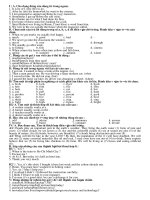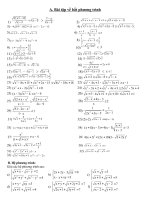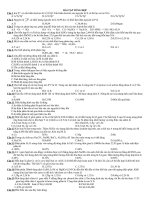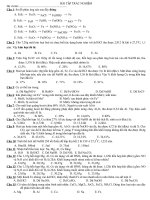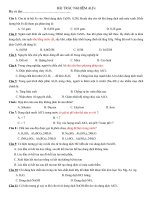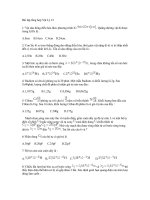Bài tập tổng hợp nhóm B1-2, B2-2, B3-2
Bạn đang xem bản rút gọn của tài liệu. Xem và tải ngay bản đầy đủ của tài liệu tại đây (920.62 KB, 10 trang )
<span class='text_page_counter'>(1)</span><div class='page_container' data-page=1>
<b>Characterization of the ICP4 gene in pathogenic Marek’s disease </b>
<b>virus of poultry in Gujarat, India, using PCR and sequencing</b>
<b>Irshadullakhan H. Kalyani1<sub>, Mahesh M. Tajpara</sub>1<sub>, Mayur K. Jhala</sub>1<sub>, Bharat </sub></b>
<b>B. Bhanderi1<sub>*, Jitendra B. Nayak</sub>2<sub>, and Jayantilal H. Purohit</sub>1</b>
<i>1<sub>Department of Veterinary Microbiology, College of Veterinary science and animal husbandry, anand </sub></i>
<i>agricultural University, anand, Gujarat, india</i>
<i>2<sub>Department of Veterinary Public health, College of Veterinary science and animal husbandry, anand </sub></i>
<i>agricultural University, anand, Gujarat, india</i>
<b>KalyaNI, I. H., M. M. TaJPaRa, M. K. JHala, B. B. BHaNdeRI, J. B. NayaK, </b>
<b>J. H. PuRoHIT</b>: <b>Characterization of the ICP4 gene in pathogenic Marek’s disease </b>
<b>virus of poultry in Gujarat, India, using PCR and sequencing.Vet. arhiv 80, </b>
<b>683-692, 2010.</b>
<b>aBsTRaCT</b>
A total of 34 clinical samples were collected for detection of Marek’s disease virus (MDV) by polymerase
chain reaction assays using primers M1.1/M1.8 to amplify a region of the ICP4 gene in layer birds of poultry.
Primer set M1.1/M1.8 amplified a 318 bp product as against the expected 247 bp product in 30 samples out
of 34 samples tested. To confirm the result, this primer was subjected to NCBI BLAST, and it was found that
the primer specific segment of 318 bp does exist in the published sequence of Md5 and Md11BAC. The PCR
product was sequenced and resulted in 273bp by direct sequencing. The sequence was analysed using NCBI
blast and Clustal W with the published sequence of Gallid herpes virus-2 giving a matching score of 97, 96 and
90% indicating a highly conserved region. This shows that the MDV is prevalent in Gujarat.
<b>Key words: </b>Marek’s disease virus, ICP4 gene, polymerase chain reaction
<b>Introduction </b>
One of the most economically devastating infectious diseases of poultry is Marek’s
disease (MD), caused by Marek’s disease virus (MDV), an oncogenic avian herpesvirus.
MD in chickens is commonly characterized by a generalized lymphomatosis involving
lymphocytic infiltration of nerves and other organs. Clinical manifestations can be
numerous and varied, including paralysis, skin lesions, atrophy of the thymus and bursa
*Corresponding author:
</div>
<span class='text_page_counter'>(2)</span><div class='page_container' data-page=2>
of Fabricius, immunosuppression, and high mortality. MD commonly appears in 3 to 4
week old chickens and gradually builds to a peak between 12 to 30 weeks of age.
The presence of MD and/or MDV has been reported from different states in India,
like Orissa, Andhra Pradesh, Arunachal Pradesh and Tripura (PRADHAN and NAYAK,
1973; REDDY et al., 1980; VERMA et al., 1989). In Gujarat, cases of MD were reported to
exist from 1971 and the incidence was increasing, as reported by VARIA et al. (1972). They
found that on each farm in the study, five to 60 percent birds were found ailing, showing
various symptoms suggestive of MD. On an average, mortality ranged from five to 30
percent in the older age group and in the younger age group, rarely less than 15 percent,
commonly 20 to 30 percent and as high as up to 60 percent. POSIA (2003), screened ten
serum and ten feather follicle samples from each of the 20 selected commercial broiler
farms in Gujarat, and found that overall seroprevalence of MD was 7.5 percent.
The technique for diagnosis of infection with MDV is isolation and identification
of MDV from infected tissues. Virus isolation is usually by virus propagation in cell
culture and identification/quantification by cytopathic changes (plaque formation) or
identification of the infected cells by immunostaining (De LANEY et al., 1998). Polymerase
chain reaction (PCR) has emerged in recent years as an additional diagnostic tool,
offering the advantages of serotype specificity (De LANEY et al., 1998) and the ability to
differentiate between the vaccinal and wild strain of MDV serotype-1 (BECKER et al.,
1992; SILVA, 1992; HANDBERG et al., 2001).
The MDV ICP4 homolog gene maps to the BamHI-A fragment, lying within the
inverted repeat flanking the unique short region of the MDV genome (CANTELLO et al.,
1994). The predicted coding region is 4,245 nucleotides long, and the predicted protein
has an overall structure similar to those of other ICP4-related proteins in that two distinct
regions of the protein are highly conserved. Several potential transcriptional regulatory
sites, including ICP4 autoregulatory sites, octamer motifs, and potential cap sites, are
present upstream and downstream of the predicted translational start site. A family of
latency-related transcripts that is abundant in lymphoblastoid cells has been identified, and
these transcripts are complementary to and overlap the predicted start site of translation
of the MDV ICP4 homolog (CANTELLO et al., 1994; McKIE et al., 1995). The patterns
of expression of these RNAs suggest that they are involved in the molecular switches
important for turning off MDV replication when the virus resides in a non-permissive
environment and needs to assume the latent state. In addition, stable transfection of a
lymphoblastoid cell line with the ICP4 homolog gene expressed from a constitutive
promoter results in dramatic up-regulation of pp38 gene expression (PRATT et al., 1994).
</div>
<span class='text_page_counter'>(3)</span><div class='page_container' data-page=3>
fractions, purified by immuno affinity, showed that CD4 and AV 37 fractions from
lymphomas expressed meq and small RNA antigen antisense to ICP4 (SAR).
TULMAN et al. (2000) presented the first complete genomic sequence, with analysis
of a very virulent strain of MDV serotype-1 Md5. The genome is 1,77,874 bp and was
predicted to encode 103 proteins. MDV1 is a coline with the prototypic herpes simplex
virus type 1 (HSV-1) within the unique long (UL) region, and it is most similar at the
amino acid level to MDV2, herpesvirus in turkeys (HVT), and non-avian herpesviruses,
equine herpesviruses 1 and 4. MDV1 encodes 55 HSY-1 UL regions homologous together
with six additional UL proteins that are absent in non-avian herpesviruses. The unique
short (US) region is colinear with and has greater than 99% nucleotide identity to that
of the MDV strain GA. However, an extra nucleotide sequence at the Md5 US/short
terminal repeat boundary results in a shorter US region and the presence of a second
gene (encoding MDV 097) similar to SORF2 gene Md5, like HVT, encodes an ICP4
homologous that contains a 900-amino acid-amino-terminal extension not found in other
herpesviruses. Md5 contains only two copies of the 132 bp repeat, which has previously
been associated with viral attenuation and loss of oncogenicity.
The ICP4 gene belongs to a major category of genes in MDV, classified or grouped
under genes homologous with alphaherpesviruses. This is a broad category of genes
further divided into immediate early, early and late genes, which are, with few exceptions,
important for virus replication. The primer to amplify ICP4 fragment of MDV-1 was
designed as per the sequence published by HANDBERG et al. (2001).
Changes in MDV and MD are numerous and are brought about by many intercurrent
forces. Understanding and anticipating these changes are fundamental to achieve further
progress in the poultry industry. The technology of nucleic acid amplification is now
widely applied in the diagnosis of poultry diseases. MDV infection has been known to
occur in this state and country for the past 35 years or more, but work involving to detection
of MDV by PCR and other aspects like genetic characterization by DNA sequencing has
not been done. Keeping these facts in view, the present study was undertaken for the
characterization of the ICP4 gene in MDV from clinical samples of chicken in layer birds
by PCR and genetic characterization of the field MDV by sequencing the PCR targeted
ICP4 gene segment, from the selected areas of Gujarat state, India.
<b>Materials and methods</b>
</div>
<span class='text_page_counter'>(4)</span><div class='page_container' data-page=4>
samples and 9 spleen samples), with a history of mortality and postmortem lesions
suggestive of MD. The birds were vaccinated with HVT + serotypes 2 virus.
<i>reference strains. </i>One Lyophilized freeze-dried live HVT vaccine (HVT-126)
obtained from the Division of Standardization, IVRI, Izatnagar, U.P., India and three
commercially available vaccine strains, namely Cell free HVT vaccine, Cell associated
HVT vaccine and Cell associated MDV-2 (serotype-2 MDV) vaccine, were obtained from
Ventri Biologicals Ltd., Pune, India.
<i>Dna extraction.</i> Extraction of DNA from feather tips was carried out as per the
procedure described by HANDBERG et al. (2001). DNeasy Tissue Kit (Catalog no. 69504,
QIAGEN Pvt. Ltd) was used for extraction of DNA from tissue samples and vaccines.
<i>PCr. </i>The primers to amplify ICP4 fragment of MDV-1 were designed as per the
sequence published by HANDBERG et al. (2001). PCR was performed using the forward
primer M1.1 5’ GGATCGCCCACCACGATTACTACC 3’ and reverse primer M1.8 5’
ACTGCCTCACACAACCTCATCTCC 3’, targeting a nucleotide sequence in ICP4 gene
(unique for MDV-1). Primer set M1.1/M1.8 amplified a 318 bp product as against expected
247 bp product in 30 samples. To confirm the results, these primers were subjected to
NCBI BLAST, and it was found that the primer specific segment of 318 bp does exist in
the published sequence of Md5 and Md11BAC. The primer for the targeting gene was
synthesized from MWG, Bangalore, India. PCR was carried out in a final reaction volume
of 25 µL using 200 µL capacity thin wall PCR tube containing 3 àL template DNA, 10ì
PCR buffer (Sigma Aldrich, USA), 25 mM MgCl2, 200 µM of the four dNTPs, 10 pmol
of each primer, and 1U Taq DNA polymerase (Sigma Aldrich, USA). The PCR tubes
with all the components were transferred to a thermal cycler (Eppendorf Master Cycler,
Germany). The PCR protocol used for the primer was initial denaturation at 94°C for
1min, followed by 31 cycles of denaturation at 94 °C for 1min, annealing 55 °C for 10s
and extension 72 <sub>°C for 1min, and final extension at 72</sub><sub>°C for 10 min. </sub>
<i>Sequencing of M1.1/M1.8 primer amplified PCR product. </i>
<i>Materials</i>. (a) One sample was selected from the PCR product of M1.1/M1.8
amplified a 318 bp. (b) BigDye® Terminatorv1.1Cycle Sequencing Kit with following
components.
i) Ready reaction premix
</div>
<span class='text_page_counter'>(5)</span><div class='page_container' data-page=5>
<i>Methods. </i>Cycle sequencing was performed following the instructions supplied
along with the BigDye® <sub>Terminatorv1.1 Cycle Sequencing Kit. The reaction was carried </sub>
out in a final reaction volume of 20 µL using 200 µL capacity thin wall PCR tube. The
composition of the reaction mixture for cycle sequencing contained 4 µL of 2.5X ready
reaction premix (final concentration 0.5X), 2 µL of 5X big dye sequencing buffer (final
concentration 1X), 1 µL forward primer BamHI (3.2 pmol/µL), 5 µL PCR product (30
ng/µL), 8 µL deionized water with 20 µL final reaction volume. The tubes containing
the mixture were tapped gently, spun briefly and then the tubes with all the components
were transferred to a thermal cycler. The cycling protocol for sequencing reaction was
designed for 25 cycles, with initial denaturation at 94 °C for 5min, denaturation at 94 °C
for 30sec, annealing 55 °C for 10sec, extension 72 °C for 4min and the thermal ramp rate
of 1 °C per second.
<i>Purification of extension products. </i>Before subjecting the extension products for
electrophoresis through the POP-6™ <sub>polymer filled capillary of the automated DNA </sub>
sequencer (ABI PRISM®<sub> 310 Genetic Analyzer, Applied Biosystems, USA), using </sub>
BigDye®<sub> Terminator v3.1 Cycle sequencing kit (Applied Biosystems, USA), the </sub>
unincorporated dye terminators were removed completely by ethanol precipitation in the
presence of EDTA and sodium acetate as follows: The 20 µL extension product was
mixed thoroughly with 2 µL of 125 mM EDTA, 2 µL of 3 M sodium acetate and 50 µL of
100% ethanol. DNA was allowed to precipitate by incubating the mixture for 15 minutes
at room temperature, the precipitated DNA was pelleted by centrifuging at 11,000 rpm
for 45 minutes at 4°C, the pellet was washed with 70 µL of 70% ethanol by centrifuging
at 11,000 rpm for 15 minutes at 4 °C. Finally the pellet was dried and re-suspended in 20
µL formamide.
<i>electrophoresis and data analysis</i>. Electrophoresis and data analysis were carried
out on the ABI PRISM® <sub>310 Genetic Analyzer using appropriate Module, Basecaller, </sub>
Dyeset/Primer and Matrix files.
<i>sequence analysis. </i>The nucleic acid sequence obtained from the 273bp PCR products
were aligned with known sequences of ICP4 of MDV genome available in Genbank®<sub>. </sub>
The nucleotide sequences (excluding primer sequences) amplified by PCR were aligned
using the Clustal W programme (THOMPSON, 1994).
<b>Results </b>
</div>
<span class='text_page_counter'>(6)</span><div class='page_container' data-page=6>
<i>sequencing. </i>A PCR (318bp approx) product of the above field sample was selected,
purified and sequenced directly using the sequencing protocol as described earlier. The
sample resulted in 273 bp (MDVICP4) long sequences, the remaining length of base pairs
did not show a high confidence level and hence were not used for further analysis in the
study.
<i>sequence obtained</i>. >MDVICP4
5’GAAGAATCAGCCCGCGGTCTGGGGGGCGACGGAGATGGTGACCTAGATGATG
AAGGTGAGGACAGGACGATTAGAGAAGATGATGACGGTGAGGAT
GATGAAGAGGAGGAAGATGAAGAGGATGGCGATCTGGAAACATGT
CCGACGTTCCGGTGAGTAGTATTGGATGGGGGATTCCGGGGAGGGGATATA
ATAATGTGCTCTTTTGACGGTGAAGTCTCAGGGCCGCGTGGTCTGGGG
GAACCTCTTGGAGATGAGGTTGGGTGAGGCCT 3’
Table 1. Nucleotide -nucleotide BLAST of primer unique to ICP4 gene of published MDV
sequences
Accesion No. Location Length Location ofICP4 Length (bp)
gb/AF14806.2 145079-145397<sub>167651-167379</sub> 318<sub>318</sub> 141467-148438<sub>164315-171286</sub> 6971
gb/AY510475.1 157726-158044 318 154120-161085
6965
gb/AF243438.1 147410-147728<sub>171034-170716</sub> 318<sub>318</sub> 143804-150769<sub>167675-174640</sub>
Fig. 1. Agarose gel electroforesis pattern of MDV1CP4 gene specific PCR products
(Approximately 318bp) amplified with primer pair M 1.1/M 1.8. M: DNA molecular weight
</div>
<span class='text_page_counter'>(7)</span><div class='page_container' data-page=7>
Table 2. Nucleotide -nucleotide BLAST of primer unique to ICP4 gene of submitted MDV
sequences
Seq A sequenceName of Length (nt) Seq B Name of Isolate/sequence Length (nt) Score
MDVICP4 273 2 Gallid herpesvirus 2, complete gi|49349068_145079-145397
genome 319 97
1 MDVICP4 273 3
gi|41387571_157726-158044
Gallid herpesvirus 2 clone
Md11BAC replication
interme-diate, complete genome
319 96
2 <sub>145079-145397 </sub>gi|49349068_ 319 3
gi|41387571_157726-158044
Gallid herpesvirus 2 clone
Md11BAC replication
interme-diate, complete genome
319 99
1 Reverse compli-MDVICP4
ment 273 2
gi|49349068_167379-167651
Gallid herpesvirus 2 complete
genome 643 90
1 Reverse compli-MDVICP4
ment 273 3
gi|10180697_170716-171034
Gallid herpesvirus 2 serotype 1
isolate Md5, complete genome 319 96
2 <sub>167379-167651 </sub>gi|49349068_ 643 3 Gallid herpesvirus 2 serotype 1 gi|10180697_170716-171034
isolate Md5, complete genome 319 85
<b>discussion</b>
</div>
<span class='text_page_counter'>(8)</span><div class='page_container' data-page=8>
Considering the above fact, the PCR product amplified by a primer pair M 1.1/M 1.8
was selected for sequencing analyses to discover exactly whether the amplified fragment
contained the ICP4 region. A PCR (318 bp approx) product of the above field sample
was resulted in 273 bp (MDVICP4) long sequences. To confirm the result, the obtained
sequence of 273 bp (MDVICP4) was subjected to NCBI BLAST and Clustal W. It was
found that the obtained sequence matched the published sequence
gi|49349068_145079-145397 - Gallid herpesvirus 2 complete genome and gi|41387571_157726-158044-Gallid
herpesvirus 2 clone Md11BAC replication intermediate complete genome, 97 percent
and 96 percent respectively, while the reverse compliment (because genome of MDV
consists of a unique long region and a unique short region bound by inverted repeats) of
the obtained sequence MDVICP4 is a match for the published sequence gi|10180697_
170716-171034-Gallid herpesvirus 2 serotype 1 isolate Md5 complete genome and
gi|49349068_167379-167651-Gallid herpesvirus 2 complete genome, 96 percent and 90
percent respectively (Table 2). Alignment of 273 bp sequences and reverse compliment
of the obtained sequence of the sample with previously published sequences of MDV
isolates revealed that the representative field isolate of the present study shared maximum
homology, as expected, due to the highly conserved region.
Hence, the primer pair M 1.1 / M 1.8 could be used for detection of MDV. The
obtained sequence of 273 bp (MDVICP4) matched 97 percent with
gi|49349068_145079-145397, 96 percent with gi|41387571_157726-158044 and gi|10180697_170716-171034
and 90 percent with gi|49349068_167379-167651. The alignment of the 273 bp sequence
of MDDVICP4 with MDV published sequences, indicated that the sample contained
a genome (fragment) of MDV-1 only. The PCR product was specifically selected for
sequencing study, because the part of the MDV genome which is amplified with this set
of primer, only exists in MDV-1 and not in MDV-2 or MDV-3 and the results were as per
expectations and in accordance with other published reports concerning the same.
<b>References</b>
BECKER, Y., Y. ASHER, E. TABOR, I. DAVIDSON, M. MALKINSON, Y. WEISMAN (1992):
Polymerase chain reaction for differentiation between pathogenic and non-pathogenic serotype
1 Marek’s disease viruses (MDV) and vaccine viruses of MDV-serotypes 2 and 3. J. Virol.
Methods. 40, 307-327.
CANTELLO, J. L., A. S. ANDERSON, R. W. MORGAN (1994): Identification of
latency-associated transcripts that map antisense to the ICP4 homolog gene of Marek’s disease virus.
J. Virol. 68, 6280-6290.
</div>
<span class='text_page_counter'>(9)</span><div class='page_container' data-page=9>
HANDBERG, K. J., O. L. NIELSEN, P. H. JERGENSEN (2001): The use of serotype 1 and
serotype 3 - specific polymerase chain reaction for the detection of Marek’s disease virus in
chickens. Avian Pathol. 30, 243-249.
McKIE, E. A., E. UBUKATA, S. HASEGAWA, S. ZHANG, M. NONOYAMA, A. TANAKA
(1995): The transcripts from the sequences flanking the short component of Marek’s disease
virus during latent infection form a unique family of 39-coterminal RNAs. J. Virol. 9,
1310-1314.
POSIA, R. U. (2003): Status of Marek’s disease and chicken infectious anemia in commercial
broiler birds - serological and pathological study. Thesis. Master of Veterinary Science, Anand
Agricultural University, Gujarat, India.
PRADHAN, H. K., B. C. NAYAK (1973): Preliminary observations on the incidence of Marek’s
disease in Orissa. Indian J. Anim. Sci. 43, 255-257.
PRATT, W. D., J. CANTELLO, R. W. MORGAN, K. A. SCHAT (1994): Enhanced expression of
the Marek’s disease virus-specific phosphoproteins pp38/41 after stable transfection of MSB-1
cells with the Marek’s disease virus homolog of ICP4. Virology 201, 132-136.
REDDY, S. D., V. N. PARGAONKAR, K. G. MOORTHY (1980): Serological survey of Marek’s
disease by agar gel precipitation test. Indian Vet. J. 57, 185-189.
ROSS, L. J. N., G. O’SULLIVAN, C. ROTHWELL, G. SMITH, S. C. BURGESS, M. RENNIE, L.
F. LEE, T. F. DAVISON (1997): Marek’s disease virus EcoRI-Q gene (meq) and a small RNA
antisense to ICP4 are abundantly expressed in CD4+ cells and cells carrying a novel lymphoid
marker, AV37, in Marek’s disease lymphomas. J. Gen. Virol. 78, 2191-2198.
SILVA, R. F. (1992): Differentiation of pathogenic and non-pathogenic serotype 1 Marek’s disease
viruses (MDVs) by the polymerase chain reaction amplification of the tandem direct repeats
within the MDV genome. Avian Dis. 36, 521-528.
THOMPSON, J. D., D. G. HIGGINS, T. J. GIBSON (1994): CLUSTAL W, improving the sensitivity
of progressive multiple sequence alignment through sequence weighting, position-specific gap
penalties and weight matrix choice. Nucleic Acids Res. 22, 4673-4680.
TULMAN, E. R., C. L. AFONSO, Z. LU, L. ZSAK, D. L. ROCK, G. F. KUTISH (2000): The
genome of a very virulent Marek’s disease virus. J. Virol. 74, 7980-7988.
VARIA, M. R., T. N. VAISHNAV, G. Y. UMERJI (1972): Marek’s disease in Gujarat. GUJVET 6,
33-37.
VERMA, N. D., D. SHARMA, S. S. GHOSH, K. C. VERMA, J. M. KATARIYA, S. D. SINGH
(1989): Serological screening against common infections of poultry diseases in Tripura State.
Indian J. Anim. Sci. 59, 362-364.
</div>
<span class='text_page_counter'>(10)</span><div class='page_container' data-page=10>
<b>KalyaNI, I. H., M. M. TaJPaRa, M. K. JHala, B. B. BHaNdeRI, J. B. NayaK, </b>
<b>J. H. PuRoHIT</b>: <b>Karakterizacija gena ICP4 patogenoga virusa Marekove bolesti </b>
<b>dokazanoga u peradi u Gujaratu u Indiji lančanom reakcijom polimerazom i </b>
<b>sekvenciranjem.Vet. arhiv 80, 683-692, 2010.</b>
<b>SAŽETAK</b>
Prikupljena su 34 uzorka kliničkoga materijala nesilica za dokaz virusa Marekove bolesti lančanom
reakcijom polimerazom uporabom početnica M1.1/M1.8 za umnažanje područja gena ICP4. Uporabom seta
početnica M1.1/M1.8 umnožen je proizvod od 318 bp u odnosu na očekivani od 247 bp u 30 od 34 pretražena
uzorka. Za potvrdu rezultata početnica je bila analizirana pomoću programa NCBI BLAST, te je ustanovljeno
da početnica za specifičan odsječak od 318 bp postoji u objavljenoj sekvenci Md5 i Md11BAC. Proizvod
PCR-a bio je izrPCR-avno sekvencirPCR-an te je ustPCR-anovljeno dPCR-a sPCR-adrži 273 bp. Slijed je bio PCR-anPCR-alizirPCR-an uporPCR-abom progrPCR-amPCR-a
NCBI BLAST i Clustal W i uspoređen s objavljenim slijedom za kokošji herpesvirus 2 te je ustanovljena
podudarnost od 97, 96 i 90% što upućuje na genski jako očuvano područje. To pokazuje da je virus Marekove
bolesti proširen u Gujaratu.
</div>
<!--links-->

